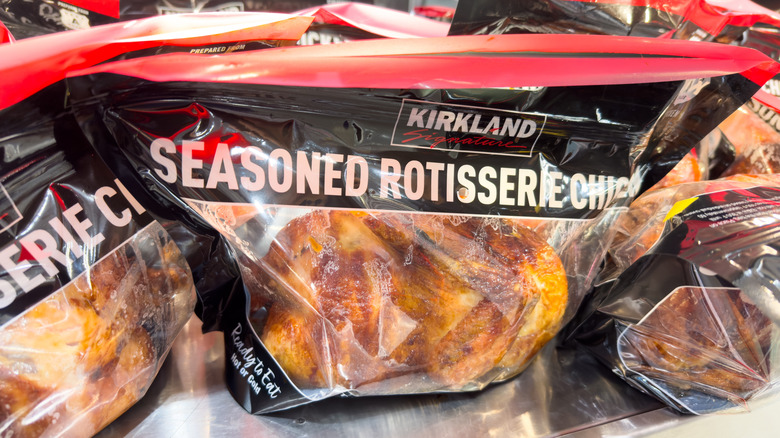Here's What A Juicy Rotisserie Chicken Should Feel Like When You Pick It Up
Whether you're trying to put together a home-cooked meal in a hurry, or need a fast, tasty protein to stir into your favorite two-ingredient mac and cheese sauce, we can all agree that the rotisserie chicken is the unsung hero of the grocery store. After all, where else can you get a fully cooked, beautifully seasoned whole chicken for just about $5? At least, that's Costco's standard pricing, though many chains' prices are comparable. Roasted in-store, these chickens are beloved not only for their low cost, but also because they combine the convenience of prepared food with the flavor of a homemade meal.
Of course, that's assuming you know how to identify the juiciest and freshest rotisserie chicken. Though cooking them on-site helps ensure they stay fresh and succulent for longer, there's always a chance you'll bring home a dry, rubbery chicken that sat under the warming lamps for too long. As long as it's golden brown and smells okay, it's likely still safe to eat — it just might not be suitable to serve as the centerpiece of a semi-homemade chicken dinner.
The easiest way to tell whether or not your bird is juicy and moist is to feel how heavy it is. Much like a handful of grapes feels heavier than a handful of raisins, a succulent chicken will feel heavier than one that's dried out because the juices add weight. If you pick up a chicken and it feels oddly light, it's best to trade it out for another one.
Other signs of a fresh bird, and clever ways to use it
If you're having a hard time deciding whether the rotisserie chicken you're holding feels heavy enough, there are some other details that can help you decide which one is the juiciest. The most telling details will show up in the skin. Ideally, it should be taut, unbroken, and golden brown. Skin that's split could indicate the chicken is becoming dry. Similarly, too many wrinkles indicate the meat underneath has started to shrink and is no longer plump with juice.
Additionally, rotisserie chicken may sometimes have scorch marks from rotating on the spit, but if the skin closest to the warming lamp is fairly dark, that may mean it's been there a while. If all else fails and the selection under the warming shelf looks particularly lackluster, you can always check the timestamps, or ask when the next batch of chickens will be ready. Health codes typically require stores to replace chickens with fresh roasters every two to four hours, so it might be worth the wait to snag a bird right off the spit.
Of course, once you get your chicken home, it's bound to get a bit dry in the fridge. Fortunately, you can mask this texture or revive it by using up your leftover rotisserie chicken in things like white bean chicken chili, curried turmeric chicken salad, or extra cheesy quesadillas and tacos. You can also roast leftover bones and skin to prep them for some truly delicious bone broth.

